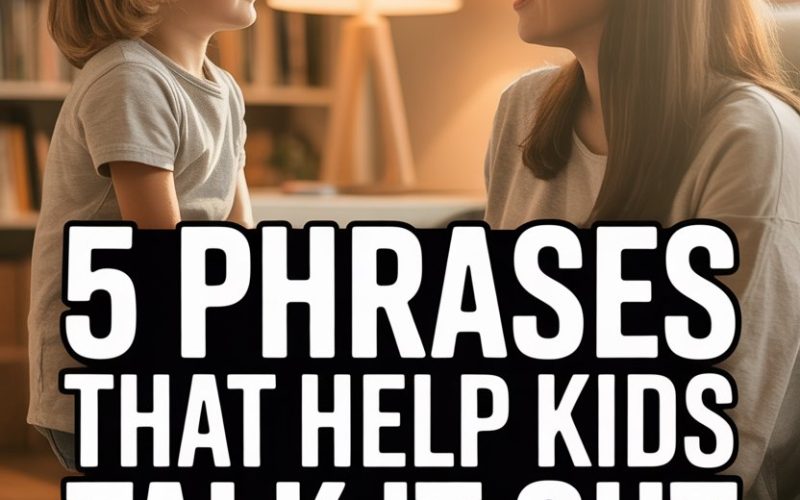Kids and communication: a pairing as natural as peanut butter and jelly, yet sometimes just as sticky.
Whether it’s sibling squabbles, mysterious moods, or the stonewalling silence that descends when you ask, “How was your day?”—getting kids to actually talk things out can feel like trying to coax a cat into a bubble bath.
Fear not. A handful of phrases, carefully wielded, can open up even the most tight-lipped child.
Here’s how to get the conversation started, keep it rolling, and—occasionally—escape with your sanity intact.
1. Can you tell me more about that?
Sometimes “Why did you do that?” is received like a police interrogation. Kids clam up, dig in, or begin inventing new and spectacular versions of events (aliens, a rogue squirrel, etc.).
Swap that for “Can you tell me more about that?” Suddenly, you’re not an accuser; you’re an interested party, genuinely curious about their perspective.
This gentle prompt signals safety. It shifts the focus from judgment to curiosity, creating space for details to tumble out.
Child psychologist Dr. Laura Markham suggests that open-ended invitations help children feel heard, which in turn builds trust and confidence.
Don’t worry if the answer meanders (“Well, Jimmy said I was a banana, and then I felt funny, and then my shoelace broke…”). Each detail is a breadcrumb leading you to the heart of the matter.
The bonus? This phrase works at every age, from toddlers to teens. You might just need to brace for longer stories as their vocabularies (and drama) expand.
2. What do you wish would happen next?
When emotions are running high—tears, tantrums, or the silent treatment—kids often feel stuck. This phrase hands them a tool to shift gears from venting to thinking about solutions.
“Sorry I hit my brother, but he looked at me weird!” Classic. You could launch into a lecture, or you could try: “What do you wish would happen next?”
This simple question invites your child to imagine a better outcome. It’s a technique promoted by conflict resolution specialists (the sort who help actual adults play nicely in the workplace).
Kids get a chance to express their hopes and ideas, which makes it more likely they’ll buy in to any solutions you propose.
If their answer is “I wish he’d move to Antarctica,” take it in stride. You’re not promising to book flights for sibling banishment. Instead, acknowledge the feeling and guide them toward something more realistic.
This approach helps kids move past the problem toward problem-solving—a priceless life skill (and, let’s be honest, a parent’s best shot at avoiding repeat performances).
3. I noticed you seem…
Sometimes, kids can’t—or won’t—name their feelings.
Maybe they don’t have the words. Maybe they’re worried about upsetting you. Or maybe, like many adults, they’re just not sure what’s bubbling under the surface.
Cue: “I noticed you seem…” Fill in the blank with whatever you observe: quiet, frustrated, excited, worried. This statement is a gentle way to put feelings into words, without making assumptions or accusations.
According to child development research at the University of Washington’s Institute for Learning & Brain Sciences, naming emotions helps kids process them and makes it easier to talk about what’s going on.
This is not your cue to play amateur psychologist (“I noticed you seem to be reliving a deep existential crisis”).
Keep it simple and observational. “I noticed you seem a bit quiet today.” Then…wait. Silence is your friend here. Give them a beat to respond.
Even if they shrug, you’ve shown them you’re paying attention and that feelings are acceptable topics for conversation.
You might be met with a mumbled “I dunno.” Or you might get a flood of previously bottled-up worries about school, friends, or even the scandal of the missing biscuits.
4. How can I help right now?
Ever been hit with a meltdown or a moody spell and thought, “Do I jump in, back off, or start singing ‘Let It Go’ until the storm passes?”
Kids don’t always know what kind of support they need, but asking “How can I help right now?” gives them a sense of control and agency.
Therapists often recommend this phrase because it signals partnership and respect. It says, “I’m here with you, not just for you.”
Sometimes your child will know exactly what they want—a hug, some space, a listening ear, or maybe just a snack. Other times, they won’t, but the very act of asking reassures them they’re not alone.
Even when children reject the offer (“Nothing helps! No one understands!”), you’ve still done something powerful: you’ve let them know you care and are available.
That foundation of support is what helps them come back to you when they’re ready to talk.
And yes, sometimes the answer really is just “biscuits.”
5. What do you need to feel better about this?
Kids are remarkably resourceful, especially when given the chance to take ownership of their feelings and solutions. “What do you need to feel better about this?” isn’t just about making the bad feelings go away.
It’s about teaching self-awareness and problem-solving.
According to research on emotional intelligence in children, kids who learn to identify and communicate their needs are better equipped to handle stress, build healthy relationships, and bounce back from setbacks.
Sometimes, the answer is practical (“I need help with my maths homework”), sometimes it’s emotional (“I need you to listen while I talk about my friend”), and sometimes it’s a bit whimsical (“I need three marshmallows and a cuddle with the dog”).
No promises you can deliver on every request (the family dog may have his own boundaries), but the question itself is a gift. It tells your child their feelings matter, their voice is important, and you trust them to know what helps.
Building Your Own Toolkit
The best thing about these phrases? They’re not magic spells. You don’t have to wield them perfectly.
Some days, your child will open up like a well-loved storybook. Other days, you’ll get monosyllabic answers, eye rolls, and the distinct feeling you’re talking to a wall with excellent hair.
Keep going. The more you use these phrases, the more natural they’ll feel—for both of you.
Over time, your child learns that talking it out is normal, safe, and maybe even a little bit satisfying.
You’re not just surviving the daily drama; you’re raising a child who knows how to speak up, listen, and work things through. No small feat in a world that tends to reward the loudest voice or the quickest answer.
Don’t forget to treat yourself with the same kindness. When you feel the urge to hide in the pantry with a packet of biscuits, remember: you’re already doing the hardest job of all—teaching tiny humans how to be decent ones.
Sometimes, that starts with the right question and a willingness to listen (preferably with both ears and at least one hand free for biscuit wrangling).
When Kids Talk, Everyone Wins
The real magic lives in these small, everyday moments when you help your child put words to big feelings.
With a few thoughtful phrases, you can transform arguments into conversations, silences into sharing, and frustration into understanding.
Try one or two tonight.
You might be surprised by what your child wants to share…and you might just learn something new about the remarkable person they are becoming.





